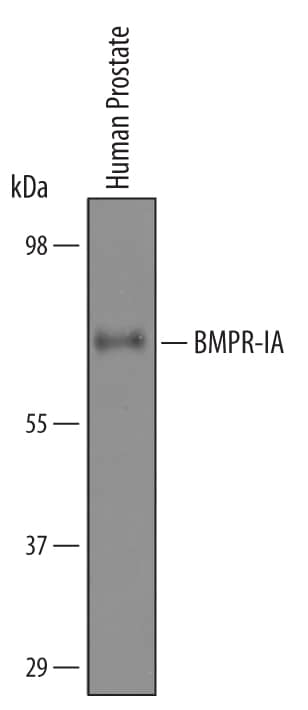Human BMPR-IA/ALK-3 Antibody
R&D Systems, part of Bio-Techne | Catalog # AF346


Key Product Details
Species Reactivity
Validated:
Cited:
Applications
Validated:
Cited:
Label
Antibody Source
Product Specifications
Immunogen
Gln24-Arg152
Accession # P36894
Specificity
Clonality
Host
Isotype
Scientific Data Images for Human BMPR-IA/ALK-3 Antibody
Detection of Human BMPR‑IA/ALK‑3 by Western Blot.
Western blot shows lysates of human skeletal muscle tissue. PVDF membrane was probed with 2 µg/mL of Goat Anti-Human BMPR-IA/ALK-3 Antigen Affinity-purified Polyclonal Antibody (Catalog # AF346) followed by HRP-conjugated Anti-Goat IgG Secondary Antibody (Catalog # HAF017). A specific band was detected for BMPR-IA/ALK-3 at approximately 60 kDa (as indicated). This experiment was conducted under reducing conditions and using Immunoblot Buffer Group 1.BMPR-IA/ALK-3 in Human Prostate Cancer Tissue.
BMPR-IA/ALK-3 was detected in immersion fixed paraffin-embedded sections of normal human prostate tissue (negative) and human prostate cancer tissue (positive) using Goat Anti-Human BMPR-IA/ALK-3 Antigen Affinity-purified Polyclonal Antibody (Catalog # AF346) at 1 µg/mL for 1 hour at room temperature followed by incubation with the Anti-Sheep IgG VisUCyte™ HRP Polymer Antibody (VC006). Tissue was stained using DAB (brown) and counterstained with hematoxylin (blue). Specific staining was localized to epithelial cells and stroma. Staining was performed using our IHC Staining with VisUCyte HRP Polymer Detection Reagents.Applications for Human BMPR-IA/ALK-3 Antibody
CyTOF-ready
Flow Cytometry
Sample: PC-3 human prostate cancer cell line
Western Blot
Sample: Human skeletal muscle tissue
Reviewed Applications
Read 1 review rated 5 using AF346 in the following applications:
Formulation, Preparation, and Storage
Purification
Reconstitution
Formulation
Shipping
Stability & Storage
- 12 months from date of receipt, -20 to -70 °C as supplied.
- 1 month, 2 to 8 °C under sterile conditions after reconstitution.
- 6 months, -20 to -70 °C under sterile conditions after reconstitution.
Background: BMPR-IA/ALK-3
Cellular responses to bone morphogenetic proteins (BMPs) have been shown to be mediated by the formation of hetero-oligomeric complexes of the type I and type II serine/threonine kinase receptors. BMP receptor 1A (BMPR-1A), also known as activin receptor-like kinase (ALK)-3, is one of seven known type I serine/threonine kinases that are required for the signal transduction of TGF-beta family cytokines. In contrast to the TGF-beta receptor system in which the type I receptor does not bind TGF-beta in the absence of the type II receptor, type I receptors involved in BMP signaling (including BMPR-IA, BMPR-IB/ALK-6, and ActR-I/ALK-2) can independently bind the various BMP family proteins in the absence of type II receptors. Recombinant soluble BMPR-IA binds BMP-4 with high-affinity in solution and is a potent BMP-4 antagonist in vitro. BMPR-IA is ubiquitously expressed during embryogenesis. In adult tissues, BMPR-IA mRNA is also widely distributed with the highest expression levels found in skeletal muscle. The extracellular domain of BMPR-IA shares little amino acid sequence identity with the other mammalian ALK type I receptor kinases, but the cysteine residues are conserved. Human and mouse BMPR-IA are highly conserved and share 98% sequence identity.
References
- Kawabata, M. et al. (1998) Cytokine and Growth Factor Reviews 9:49.
- Ebendal, T. et al. (1998) J. Neuroscience Research 51:139.
Long Name
Alternate Names
Gene Symbol
UniProt
Additional BMPR-IA/ALK-3 Products
Product Documents for Human BMPR-IA/ALK-3 Antibody
Product Specific Notices for Human BMPR-IA/ALK-3 Antibody
For research use only
